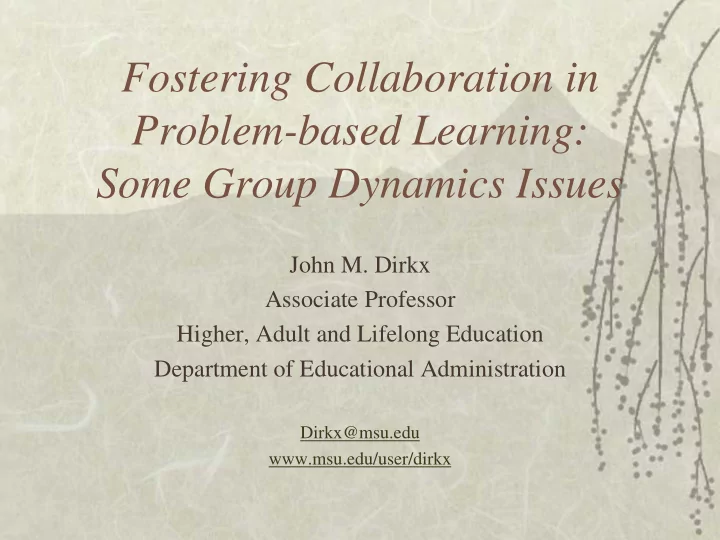

Fostering Collaboration in Problem-based Learning: Some Group Dynamics Issues John M. Dirkx Associate Professor Higher, Adult and Lifelong Education Department of Educational Administration Dirkx@msu.edu www.msu.edu/user/dirkx
Outline of Comments My teaching context The problem-based learning unit Issues with which groups struggle How I address these issues
Teaching Context EAD 861 Adult Learning � Graduate-level course on adult learning – Emphasizing research and theory – Taught online – most asynchronous – 25 participants � Problem-based – Real-life problems derived from educational practice – Increasingly complex and multi-dimensional � Combination of individual and group work – Group and individual grades – Individual work grounded in group experience – Groups use consensus process for decision-making � Groups – Three to four students – Teacher assigned – Usually diverse
Structure of Problem Units � Introduction to the case – Framing the case within the research and theory – Reading assigned material � Case scenario � Generating preliminary understanding of the case – Statement of problem – Possible factors contributing to the problem � Researching the problem – Guiding questions facilitate group research and study – Usually involves a division of labor � Developing the group report (grounded in the research) – Clear statement of problem and why it is a problem – Factors contributing to the problem – Recommendations to address the problem � Debriefing – Group process – Individual reflection on one’s learning
Process Issues � Individual versus the group – Learners want to be actively involved and to work with others – But they want to be held individually accountable for their own learning � The problem of authority – Learners need to depend on themselves and one another as emerging authorities in the cases – Yet they want to depend on instructor as primary authority � The problem of intimacy – Learners want to feel a sense of belonging within the group and need to relate and interact with one another – But developing a sense of belong and relatedness involves taking risks and disclosing aspects of oneself
Addressing the Issues � Curricular approaches – Orientation to PBL and group work – Practice problem-based unit – Group debriefing and individual reflections – Individual unit mid-way through � Instructional approaches – Resource more than primary source – Maintaining presence but posing questions, drawing attention to issues, potential contradictions, etc – Fostering integration of both content and process – Seeing individual issues as group concerns
Lingering Issues Managing the work Independence vs interdependence Integrating issues into the learning
Recommend
More recommend